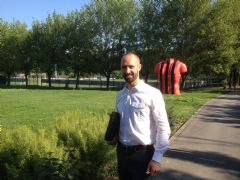Milan has been a great tutor this week. Every day, I have had a visit, or a meeting, or a trial session organised & every day I have been able to add something new to my performance philosophy or decide that something I thought might fit, really doesnít.
The visit to the Milan Lab complex at the AC Milan training facility was a wonderful example of seeing a team embrace & drive innovation in sport. Working closely with the engineering & psychology departments at the Politecnico di Milano, the club is developing some really interesting concepts in performance evaluation & physical assessment.
The training campus is a reflection of the thought & consideration that goes in to the planning of every aspect of a playerís life.
Dedicated facilities for goalkeepers to train on, a variety of surfaces for conducting different types of physical conditioning & a consistency of approach from the youngest academy teams right through to the first team (something that was apparent during my visit to FC Barcelona), are just some of the signs illustrating that attention to detail is a key characteristic that runs through the Club.
The overall impression I came away with from a physical preparation aspect, was that the philosophy at AC Milan sits somewhere between the approach I saw in FC Barcelona & those I have seen taken by clubs operating in the English Premier League.
Yet, just like the departments in Barcelona & in the English Premier League teams with whom I have worked or indeed just visited, the emphasis on objectively monitoring preparation, physical readiness to perform & recovery is far greater than any of the teams I have seen operating in American sports.
From a numbers perspective, AC Milan underlined why this is possible. In the academy complex alone, there were 7 full-time sports scientists/conditioning professionals, 6 full-time sports physiotherapists, medical staff, dedicated IT staff, a nutritionist, psychologists & performance analysts to support the coaches & players. In addition, there were part-time staff that came in when the age group teams trained & played. The whole system is then replicated in the senior set up for the first team.
Iíve sung this song before, but when it comes to American football or basketball or ice hockey, for example, that investment just isnít allocated to these areas of performance. Subsequently, the level that the sports science & sports medical services support teams are able to operate on is far lower. No reflection on the individual clinicians, more the availability of man hours to the cause.
Away from the high-level sports performance environment, I have also spent some valuable time with Gyrotonics trainers & Pilates instructors that operate with the dance population in Milan. From working with contemporary dancers to those training at La Scala Operatic Ballet school, I now have a really good understanding of the preparative strategies that are in place for these athletes of the entertainment world.
Iíve been able to clarify my hypotheses on where specific aspects of a dancerís training routine would benefit sports players & where other components just wouldnít transpose.
After meeting with Master Gyrotonics instructor, Paolo Bernasconi on Tuesday, I then took a session with him on Thursday.
In summary, I would say the biggest challenges that Gyrotonics set me were to coordinate breathing & controlled movement, whilst retaining stability around a spine & pelvis that is in motion.
All the while, the core movements involving the axial skeleton are encouraging either an opening of the anterior chain through reaching or lengthening, or an opening of the posterior chain through pulling or retracting. At the same time, the lengthening or retractions involve the appendicular skeleton & as a result, once I had worked for an hour, the joints of my hips, shoulders & spine felt decompressed, whilst the muscles stabilising them felt responsive & able to achieve a dynamic stability that had previously felt inhibited.
By encouraging a fluidity & rhythm to the movement, in order to achieve a flow from one repetition to the next, the Gyrotonic tasks require a focus on co-ordination, which isnít challenged by many disciplines that allow a pause between repetitions.
Before the session, I would evaluate the proprioceptive capabilities contributing to the movement (or lack thereof) around my lumbar spine & hips as being greatly diminished, thus impairing the ability to selectively control my lumbopelvic dissociation. By the time I was working through the last exercise, my lumbopelvic movement was smooth & under control.
As with any method of training, the quality of the work you do is dependant to a certain extent on the person that is guiding the training & I am sure that Paoloís previous training as a physiotherapist was integral in guiding his real-time feedback. His background in dance obviously encouraged his bias towards working with more of a musical rhythm.
To find out more about Gyrotonic Milano, click the link below:
In any case, I was extremely impressed with the session I had & both visits have served to inform my research greatly. Thank you to Paolo at Gyrotonic Milano, to Dominico, Maurizio & Oli at AC Milan, in addition to Miriam & Giuseppe for hosting me. I look forward to accepting all of your offers to visit again in the future!

